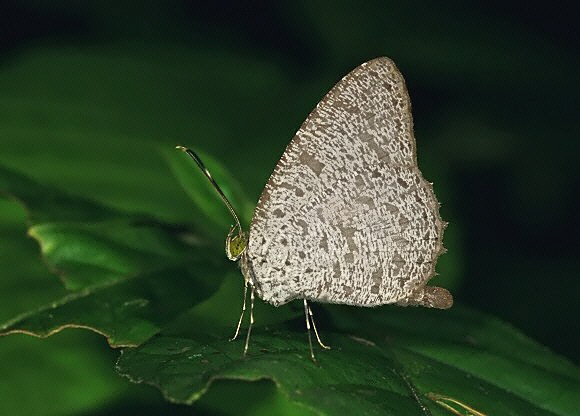
Introduction
Horsfield’s Darkie is one of several very similar species in the tribe Miletini, which are characterised by having attractively mottled and striated patterns on their underside wings, a long thin abdomen, a very long proboscis, and erect labial palpi.
The butterfly is elusive but fairly common in the lowland rainforests of peninsular Malaysia, Borneo and Sumatra. Closely related species occur throughout the Oriental region. Some are widespread, while others are endemic to particular islands or restricted altitudinally.
In common with other members of the subfamily Miletinae, this species is entirely aphytophagous, i.e. it feeds carnivorously, parasitically, or on animal by-products.
A great deal remains to be learnt about the ecology of the Miletinae. It is known that the adults and larvae of most species live in association with ants and that most feed parasitically or carnivorously on Homoptera ( aphids, coccids, psyllids and membracids ). It is probable that all Miletinae species are involved in complex 3-way symbiotic relationships with ants and Homoptera.
Habitats
Tropical dipterocarp rainforests at altitudes below about 300 metres. Other related and very similar species can be found at much higher altitudes. In my experience this species is usually found close to rivers, or in seasonally inundated forest.
Lifecycle
The butterflies are continuously brooded and can be found in roughly equal numbers at all times of year.
The eggs are laid amidst clusters of membracids ( tiny aphid-like creatures ). The caterpillars are adorned with rows of spiky humps on the back and sides. Unlike most lepidopteran larvae they do not eat plant matter, but feed parasitically on membracids during their early instars. When older they devour complete membracids. Larvae of the closely related genus Spalgis feed on coccids, while Logania feed on aphids. At least one Allotinus species apries, feeds on coccids when it is tiny. When it reaches the 2nd instar it develops tiny protrusions that are used as grapples by the ant Myrmecaria lutea to carry it to it’s nest – where the larva proceeds to devour the ant grubs. Details of the pupal stage are unknown, but pupation probably takes place within ant nests.
Adult behaviour
The butterflies are sedentary in behaviour, and semi-crepuscular in nature, becoming active just before dusk, although in dull weather conditions they may fly earlier in the day. The flight is weak, and only very short distances are covered.
They are normally encountered solitarily, or in very low numbers, and can be seen at rest on the foliage of bushes in the undergrowth, usually in the darkest recesses of the rainforest. Males perch on foliage at a height of about 1m, and use these vantage points to await passing females. Often 2 or 3 males will be found in close proximity – when males meet they chase each other rapidly back and forth until one or the other submits to bullying and flies away.
In August 2004, when exploring Mulu national park in Sarawak, I found a specimen of Allotinus horsfieldi feeding in company with ants and membracids. The membracids were piercing plant stems to fed on the sap, and were being “milked” by the ants, to obtain a sweet secretion. The butterfly, which was totally ignored by the ants and their “herd”, spent several minutes with it’s long proboscis out-stretched, imbibing the secretion directly from the backs of the membracids.
